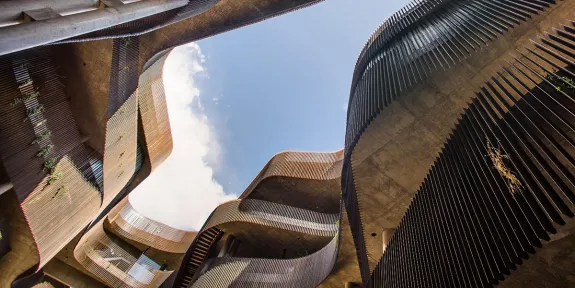
ENR2 Green Roof Project
Rooftop gardens are valuable in many ways to people and buildings. These gardens produce oxygen, reduce building energy costs, capture rainwater and reduce stormwater runoff, create habitats for wildlife, and offer beautiful natural spaces for the enjoyment of building inhabitants, among other benefits. Large rooftop gardens can even promote health and wellness by offering walking paths and other fitness opportunities.
The Environment and Natural Resources 2 Building on the University of Arizona’s main campus is LEED Platinum certified and was originally designed to feature a green roof with solar panels. In 2019, the Office of Sustainability, in partnership with Planning, Design & Construction, the School of Geography & Development, the School of Natural Resources & the Environment, the School of Landscape Architecture & Planning, the Institute of the Environment (now the Arizona Institute for Resilience) and Tucson Electric Power (TEP), received approval to move forward with a green roof and solar panel installation.
How Does It Work?
This project will couple the solar panels with hardy rooftop garden plots in a system called “agrivoltaics”. The system combines the green roof garden (“agri”-culture) with solar technology (photo-”voltaics”) to create a hybrid that maximizes the efficiency and benefits of each.
Why use agrivoltaics? Typical solar panels perform optimally at 77F, but temperatures in the Tucson area regularly exceed that threshold throughout the year, and direct solar exposure further exceeds this optimal performance temperature. Installing a living green roof below the panels allows transpiration from the plants to cool the panels, in some cases by as much as 20F, increasing the panels’ efficiency and their electrical output. In turn, shade from the panels both cools the plants and helps prevent water loss in extreme heat, increasing plant productivity by as much as 300%.
Project Updates
The construction on the green roof component of the project (Phase 1) began in November 2019, with completion at the end of January 2020. The installation of the solar panels (Phase 2) began in May 2020, with completion in January 2021. Once fully complete, the green roof will be planted with a variety of native, pollinator-friendly plants and will be maintained in a manner that provides habitat and food resources for our native pollinators.
Phase 1 of the ENR2 Rooftop Photovoltaics (PV)+ Project
STAY CONNECTED
Follow ENR2 on Instagram for updates @uazenr2!
Interested in learning more? Want to collaborate? Get in contact!

